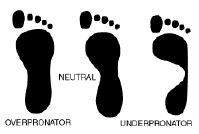|
Shoe Guide
Running shoes
are the most important item of running kit you will buy.
Each time your foot hits the ground there is force of around
two-and-a-half times your body weight and your shoes are
there to protect you from this. Add to this the fact that
because of technology that goes into making running shoes
they can cost a fair amount of money, so the right choice
becomes even more important. Below is a guide to which shoes
to buy...
Step One- Know
your style
Before buying a
new pair of shoes don't sling out your old ones. First,
stand them up on the table and see what they do...
-
If they lean inwards, you're an
OVER-PRONATOR (abbreviated to PRONATOR in the guide).
-
If you're shoes stand flat, you are
NEUTRAL.
-
If they lean outwards, you are and
UNDER-PRONATOR.

Still not sure which one you are? Walk across
a tiled floor with wet feet. Look at the marks. If the line
connecting heel to toes is wider that half your foot width,
you're a PRONATOR. If there's a thin line you're an
UNDER-PRONATOR. Somewhere in between? You're a NEUTRAL.
Step
Two-Pick a shoe type

Step Three-Go
Choose
If you've followed all the steps listed above, you probably
have a pretty good idea of what type of running shoe you
should be looking for. However, it still pays to go to a
specialty running store (at least for your first running
shoe purchase). The people who work in these stores are
knowledgeable and will guide you to the appropriate shoe
models.
Here are some tips for a successful shopping
trip.
- Shop in the late afternoon when your feet are at their
largest. Your feet will expand while running.
- Bring your old shoes with you when you go shopping.
Shoe wear will assist the salesperson in determining
your degree of pronation.
- Do NOT make the most common mistake new runners make
by buying the latest fad shoe. It is highly likely this
will not be the ideal shoe for you.
- Make sure the salesperson measures both of your feet.
Often, one foot is slightly larger than the other. You
should be fitted for the larger foot.
Before you try on any shoes, the salesperson
should (at least) ask you the following questions to help
you select the right running shoe model.
- How long have you been running?
- How much mileage are you doing per week?
- Are you training for a particular event?
- Where do you do most of your running?
- How much do you weigh?
- Are you aware of any foot problems (i.e. flat feet,
over- or underpronation)?
Based on your answers, the salesperson will
direct you to various models that will fit your needs and
help you select some for you to try.
Wednesday, 03 March 2004 12:36
|